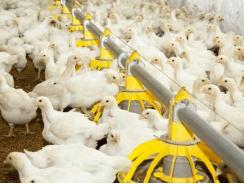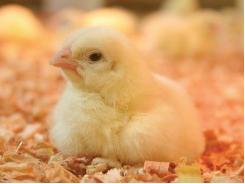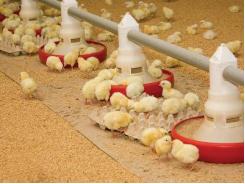Using vegetable proteins in pig and poultry feed

iStock.com | Although small grains such as wheat and barley are used in many parts of the world, maize remains the main grain used in feeds worldwide.
Research shows that it may be possible to overcome challenges and achieve eubiosis in vegetable-based feeds with a multi-enzyme system.
As animal proteins are increasingly being removed from animal feeds, vegetable-based feeds are becoming more popular. However, vegetable-based feeds are a particular challenge for the micro-flora of the gastrointestinal tract of pigs and poultry in that they have high fiber content and contain plant proteins that are generally digested less easily than animal proteins. As a result, some micro-organisms may grow exponentially on poorly digested nutrients, invade the small intestine and compete for nutrients with the host animal.
In addition, most Western countries have banned antibiotic growth promoters, which may lead to a state of dysbiosis, an uncontrolled microflora in the gastro-intestinal tract.
Eubiotic nutrition can be an important strategy in working with this challenge, and success may be achieved with the judicious use of multi-enzyme systems. Optimizing dietary fiber, together with maximizing energy and protein utilization can ensure a healthy gastrointestinal microflora. This state, known as eubiosis, occurs when lactic acid-producing bacteria are promoted while pathogenic bacteria are suppressed.
Multi-enzyme systems
When formulating feeds with high inclusions of plant proteins, we must consider possible anti-nutritional factors as well as non-available carbohydrates that comprise non-starch polysaccharides and non-digestible oligosaccharides. The various sources of non-available carbohydrates can be broken down by supplementary enzymes, and this will reduce microbial growth in the small intestines. Those carbohydrates will eventually enter the large intestine as non-digestible oligosaccharides, where they will be fermented into various organic acids and probably some amino acids.
Fiber-degrading enzymes may play a very important role in modulating this microbial fermentation when high fiber and vegetable-based feeds are used. That is why fiber levels in feed must no longer be seen as a maximum constraint in formulations. Optimizing fiber becomes the new challenge in modern feed formulations.
Feed enzymes improve the digestibility of feed ingredients. They lower the viscosity of intestinal contents and unlock nutrients that are entrapped in the plant cell structures. Enzyme products based on xylanase and b-glucanase, frequently containing cellulose, are known to improve litter conditions, particularly with wheat- and barley-based feeds. The variation in the overall content and bioavailability of carbohydrates, fats, proteins and amino acids in feeds has led to the development of various enzymes designed to liberate unavailable nutrients. Given the many biochemical processes involved in nutrient digestion, it is likely that a multiple-enzyme system would play a greater role in digestion, particularly in energy and protein utilization. More energy is released from the feed, resulting in an energy sparing effect, and more proteins become available, resulting in an amino acid sparing effect. Both can be attributed to the digestive enzymes and can be used in least-cost feed formulations.
Importance of cereal grains
Energy is the most expensive part of monogastric diets and is provided mostly by cereal grains. Wheat is known to be a highly variable ingredient, and feeding values of wheat differ with the variety and site of production. Scott et al. (1998) found a direct correlation between intestinal viscosity, the metabolizable energy and animal performances with nine wheat varieties. High-molecular-weight carbohydrate complexes, such as water-soluble pentosans, were shown to increase the viscosity of the fluid phase of the intestinal content in broilers (Bedford et al. 1991), and this is significantly reduced by the use of enzymes. Van der Klis (1994) showed that addition of endo-xylanase to broiler feed increased the apparent metabolizable energy of various wheat varieties.
Maize diets are highly digestible. However, the variation in the overall content and bioavailability of carbohydrates, fats, proteins and amino acids in maize-soybean diets has led to the formulation of various enzymes designed to liberate unavailable nutrients. It has become interesting to supplement maize-based diets with a-amylase, an enzyme also produced by animals but at levels too low in young animals, such as piglets and broilers.
Broiler performance questions
Even though the gross energy value of soybean meal is considerably higher than the metabolizable energy (18.83 MJ/kg vs. 10.25 MJ/kg), it was commonly accepted that enzyme supplementation to a maize-soybean diet would not improve broiler performance to an extent that would offer any economic benefit. Soybean meal contains non-starch polysaccharides, including arabinoxylans, pectins and beta-glucans. But, legume seeds, in particular, also contain important amounts of the a-galactosides – raffinose, stachyose and verbascose – that may affect nutrient absorption.
These oligosaccharides appear to be indigestible in the stomach and the small intestine. However, bacteria in the lower intestinal tract are able to metabolize these sugars to CO2, H2 and CH4, provoking digestive disorders. Further research has shown the impact on zootechnical performances and the cost-effectiveness of breaking down these oligosaccharides with enzymes such as a-galactosidase and b-mannanase.
Alternative protein sources
Alternative protein sources are now becoming of increasing interest: rapeseed and rapeseed meal, sunflower meal, cottonseed meal, peas, beans, lupines, and more exotic ingredients such as palm kernel meal and copra meal. The non-starch polysaccharides in pulses and oilseeds are mainly pectic polysaccharides consisting of galacturonans, or more commonly rhamnogalacturonans. Other sugars attached as side chains include D-galactose, L-arabinose and D-xylose. Multi-activity enzymes including pectinase targeting the pectic polymers, as well as the other neutral non-starch polysaccharides, are certainly of great interest.
It may be assumed as well that exogenous protease enzymes solubilize proteins and increase the protein availability, especially when it comes to vegetable protein sources. This again is of utmost important for young animals, broilers and piglets, which do not sufficiently produce this enzyme.
Good results have been obtained with such a multi-enzyme system with weaning piglets on a maize-soybean meal diet (see Table 1) and with broilers (Table 2).
Conclusions
Although small grains such as wheat and barley are used in many parts of the world, maize remains the main grain used in feeds worldwide. Modern developments have now resulted in feeds that increasingly depend upon vegetable protein sources. Soybean meal remains still the major source of plant proteins although alternative oilseed meals, such as sunflower meal and rapeseed meal, and also leguminous seeds, such as peas, beans and lupines, are gaining more interest. This inevitably will yield feeds with higher fiber contents and low digestible proteins.
The common fiber-degrading enzymes such as xylanase, a-glucanase and cellulase have shown good results with typical wheat-barley based diets. However, to gain full benefit from diets containing maize and high fiber plant proteins, a multi-enzyme system that contains other fiber-degrading enzymes such as a-galactosidase, b-mannanase and pectinase may be of great interest.
Moreover, we demand that animals grow fast with a minimum of highly concentrated feeds. However, their endogenous enzymes may not be sufficient, especially with young animals such as piglets and broilers. Therefore, a supplementation with protease and a -amylase enzymes is needed to maximize the utilization of proteins and starch. This will improve animal health as less of these nutrients will be available for the pathogenic bacteria in the digestive tract.
Có thể bạn quan tâm
Phần mềm

Phối trộn thức ăn chăn nuôi

Pha dung dịch thủy canh

Định mức cho tôm ăn

Phối trộn phân bón NPK

Xác định tỷ lệ tôm sống

Chuyển đổi đơn vị phân bón

Xác định công suất sục khí

Chuyển đổi đơn vị tôm

Tính diện tích nhà kính

Tính thể tích ao hồ




 Using maize gluten as an alternative protein source…
Using maize gluten as an alternative protein source…  7 questions to ask when purchasing broiler feeds
7 questions to ask when purchasing broiler feeds